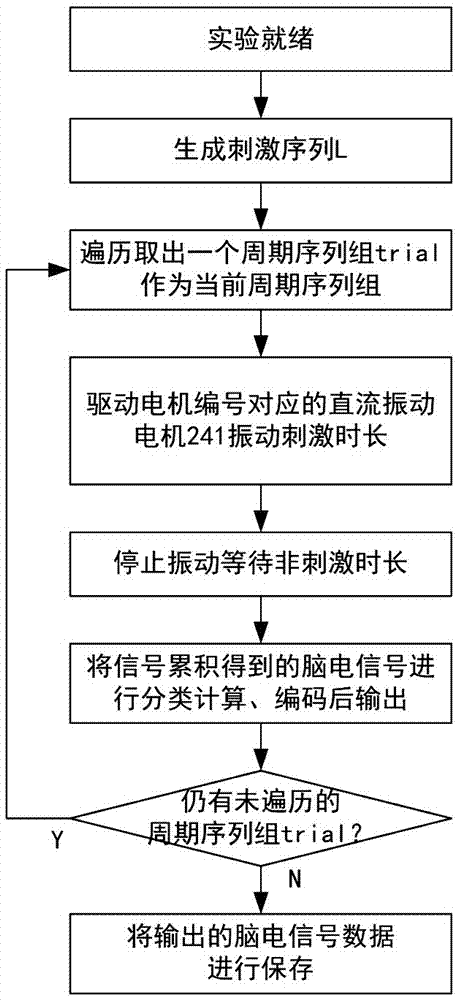Brain computer interface P300 signal characteristic somatosensory evoked device and application method therefor
A brain-computer interface and signal feature technology, applied in applications, sensors, computer components, etc., can solve the problem of not really moving towards the practical stage, and achieve the effect of overcoming low induction efficiency, reducing volume, and increasing input dimensions
- Summary
- Abstract
- Description
- Claims
- Application Information
AI Technical Summary
Problems solved by technology
Method used
Image
Examples
Embodiment 1
[0035] like figure 1 As shown, the brain-computer interface P300 signal characteristic somatosensory inducing device of this embodiment includes a host computer communication unit 1 and a lower computer unit 2, the host computer communication unit 1 includes a USB to serial port module 11, and the lower computer unit 2 includes a single-chip microcomputer 22, a motor Drive unit 23, motor unit 24 and low-voltage DC power supply 25, motor unit 24 includes a plurality of DC vibration motors 241 used as a source of tactile stimulation, single-chip microcomputer 22 is connected with USB to serial port module 11, and the output end of single-chip microcomputer 22 is passed through motor respectively The drive unit 23 is connected to each DC vibrating motor 241 , and the output end of the low-voltage DC power supply 25 is connected to the wireless communication lower module 21 , the single-chip microcomputer 22 and the motor drive unit 23 respectively. The host computer communication...
Embodiment 2
[0058] The brain-computer interface P300 signal feature somatosensory inducing device of this embodiment is basically the same as that of Embodiment 1, and its main difference is that the single-chip microcomputer 22 and the USB-to-serial port module 11 in this embodiment are directly connected to reduce costs, that is: In Embodiment 1, the wireless communication upper module 12 and the wireless communication lower module 21 are omitted, and the USB-to-serial port information input RXI, information output TXD and direct-connected control microcontroller information output TXD, information input RXI are respectively designed. However, this is only applicable to scenarios where there is no mobility requirement for the lower computer unit 2 .
[0059] The application method of the inducing device in this embodiment is completely the same as that in Embodiment 1, and will not be repeated here.
Embodiment 3
[0061] The brain-computer interface P300 signal characteristic somatosensory inducing device of this embodiment is completely the same as that of Embodiment 1, and will not be repeated here.
[0062] The application method of the inducing device in this embodiment is basically the same as that in the first embodiment, the main difference being that the vibration mode of the DC vibration motor 241 corresponding to the driving motor number is different. In this embodiment, the vibration of the DC vibration motor 241 corresponding to the driving motor number of the lower computer unit 2 in step 4) specifically means that the DC vibration motor 241 corresponding to the driving motor number of the lower computer unit 2 vibrates simultaneously at different frequencies.
PUM
 Login to View More
Login to View More Abstract
Description
Claims
Application Information
 Login to View More
Login to View More - R&D
- Intellectual Property
- Life Sciences
- Materials
- Tech Scout
- Unparalleled Data Quality
- Higher Quality Content
- 60% Fewer Hallucinations
Browse by: Latest US Patents, China's latest patents, Technical Efficacy Thesaurus, Application Domain, Technology Topic, Popular Technical Reports.
© 2025 PatSnap. All rights reserved.Legal|Privacy policy|Modern Slavery Act Transparency Statement|Sitemap|About US| Contact US: help@patsnap.com


